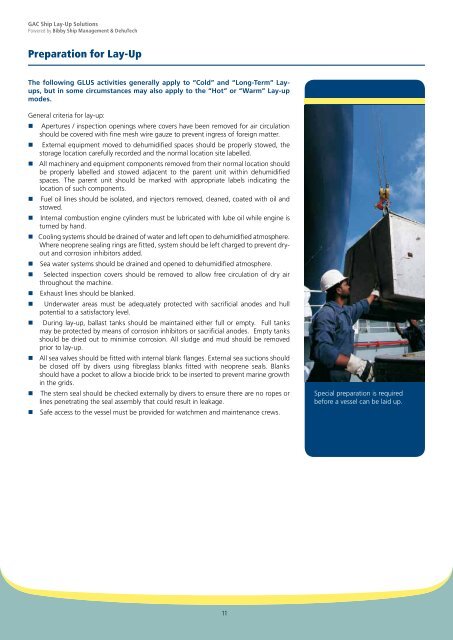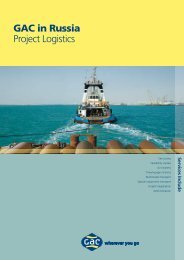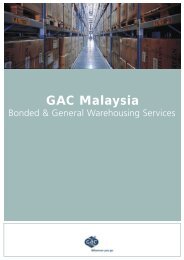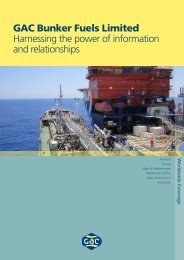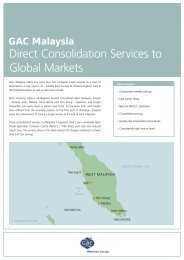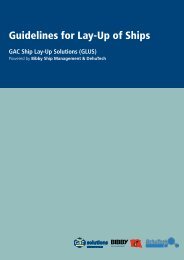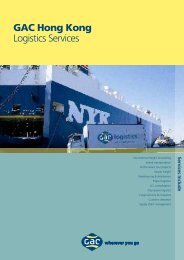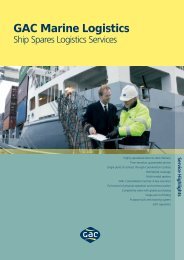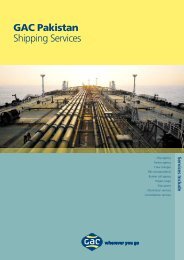Ship Lay-Up Guidelines - GAC
Ship Lay-Up Guidelines - GAC
Ship Lay-Up Guidelines - GAC
You also want an ePaper? Increase the reach of your titles
YUMPU automatically turns print PDFs into web optimized ePapers that Google loves.
<strong>GAC</strong> <strong>Ship</strong> <strong>Lay</strong>-<strong>Up</strong> Solutions<br />
Powered by Bibby <strong>Ship</strong> Management & DehuTech<br />
Preparation for <strong>Lay</strong>-<strong>Up</strong><br />
The following GLUS activities generally apply to “Cold” and “Long-Term” <strong>Lay</strong>ups,<br />
but in some circumstances may also apply to the “Hot” or “Warm” <strong>Lay</strong>-up<br />
modes.<br />
General criteria for lay-up:<br />
n Apertures / inspection openings where covers have been removed for air circulation<br />
should be covered with fine mesh wire gauze to prevent ingress of foreign matter.<br />
n External equipment moved to dehumidified spaces should be properly stowed, the<br />
storage location carefully recorded and the normal location site labelled.<br />
n All machinery and equipment components removed from their normal location should<br />
be properly labelled and stowed adjacent to the parent unit within dehumidified<br />
spaces. The parent unit should be marked with appropriate labels indicating the<br />
location of such components.<br />
n Fuel oil lines should be isolated, and injectors removed, cleaned, coated with oil and<br />
stowed.<br />
n Internal combustion engine cylinders must be lubricated with lube oil while engine is<br />
turned by hand.<br />
n Cooling systems should be drained of water and left open to dehumidified atmosphere.<br />
Where neoprene sealing rings are fitted, system should be left charged to prevent dryout<br />
and corrosion inhibitors added.<br />
n Sea water systems should be drained and opened to dehumidified atmosphere.<br />
n Selected inspection covers should be removed to allow free circulation of dry air<br />
throughout the machine.<br />
n Exhaust lines should be blanked.<br />
n Underwater areas must be adequately protected with sacrificial anodes and hull<br />
potential to a satisfactory level.<br />
n During lay-up, ballast tanks should be maintained either full or empty. Full tanks<br />
may be protected by means of corrosion inhibitors or sacrificial anodes. Empty tanks<br />
should be dried out to minimise corrosion. All sludge and mud should be removed<br />
prior to lay-up.<br />
n All sea valves should be fitted with internal blank flanges. External sea suctions should<br />
be closed off by divers using fibreglass blanks fitted with neoprene seals. Blanks<br />
should have a pocket to allow a biocide brick to be inserted to prevent marine growth<br />
in the grids.<br />
n The stern seal should be checked externally by divers to ensure there are no ropes or<br />
lines penetrating the seal assembly that could result in leakage.<br />
n Safe access to the vessel must be provided for watchmen and maintenance crews.<br />
11<br />
Special preparation is required<br />
before a vessel can be laid up.


